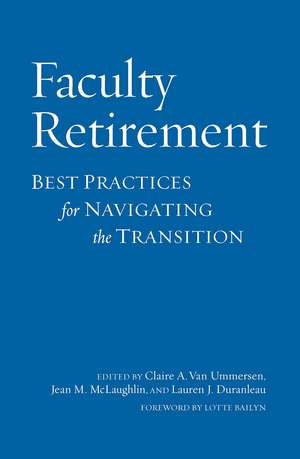Faculty Retirement: Best Practices for Navigating the Transition
Editat de Jean McLaughlin, Lauren Duranleau, Claire Van Ummersenen Limba Engleză Hardback – 11 mar 2014
| Toate formatele și edițiile | Preț | Express |
|---|---|---|
| Paperback (1) | 306.22 lei 6-8 săpt. | |
| Taylor & Francis – 7 mar 2014 | 306.22 lei 6-8 săpt. | |
| Hardback (1) | 1002.80 lei 6-8 săpt. | |
| Taylor & Francis – 11 mar 2014 | 1002.80 lei 6-8 săpt. |
Preț: 1002.80 lei
Preț vechi: 1222.94 lei
-18% Nou
Puncte Express: 1504
Preț estimativ în valută:
191.89€ • 197.96$ • 160.13£
191.89€ • 197.96$ • 160.13£
Carte tipărită la comandă
Livrare economică 27 martie-10 aprilie
Preluare comenzi: 021 569.72.76
Specificații
ISBN-13: 9781620361917
ISBN-10: 1620361914
Pagini: 280
Dimensiuni: 152 x 229 x 25 mm
Greutate: 0.53 kg
Ediția:New.
Editura: Taylor & Francis
Colecția Routledge
Locul publicării:Oxford, United Kingdom
ISBN-10: 1620361914
Pagini: 280
Dimensiuni: 152 x 229 x 25 mm
Greutate: 0.53 kg
Ediția:New.
Editura: Taylor & Francis
Colecția Routledge
Locul publicării:Oxford, United Kingdom
Public țintă
Postgraduate and Professional Practice & DevelopmentCuprins
Foreword. Lotte Bailyn, Professor of Management, Emerita, & Professor of Organization Studies, MIT Sloan School of Management Preface. Kathleen Christensen, Program Officer, Working Longer Program, Alfred P. Sloan Foundation Part One. Setting the Context 1. Redefining Faculty Retirement. Lauren J. Duranleau and Jean M. McLaughlin, American Council on Education 2. Supporting the Culminating Stages of Faculty Careers. Lauren J. Duranleau and Jean M. McLaughlin, American Council on Education Part Two. The Psychosocial Aspects of the Culminating Stages of Faculty Careers 3. Beyond the Horizon. Helping Faculty Navigate the Retirement Transition in a Small Liberal Arts Setting. Samantha Roy and Andrea Chapdelaine, Albright College 4. Understanding Retirement from a Developmental Perspective The Case of Mount Holyoke College. Caroline S. Clauss-Ehlers, Rutgers, The State University of New Jersey, and Lynn Pasquerella, Mount Holyoke College 5. Working in Community. Flexible Programming to Support Fulfilling Postretirement Careers -- Nathan D. Grawe, Carleton College Part Three. Institutional Structures That Support the Culminating Stages of Faculty Careers 6. Planning a Graceful Exit to Retirement and Beyond. The San José State University Way -- Amy Strage and Joan Merdinger, San José State University 7. Developing a Legacy -- Janette Brown, University of Southern California 8. Phasing into Retirement -- Vicki Lafarge, Bentley University 9. Starting a Retirement Association at a Small Liberal Arts College. Terence E. Diggory and Susan A. Kress, Skidmore College Part Four. Senior and Emeriti Faculty Contributions to Local Communities 10. Emeriti/ae Faculty as a Valuable Institutional Resource. Mary Lefkowitz & Kathryn Lynch, Wellesley College 11. Leveraging the Talents of Faculty Members to Create an Engaged Retirement Ecoystem at the University of Baltimore. Laura Koppes Bryan, Margarita M. Cardona, Dennis Pitta, and Beverly Schneller, University of Baltimore 12. Collaborations With the Community -- Katherine Haldeman, George Mason University Part Five. Tapping into the Bigger Picture. Missions, Systems, & National Associations 13. Working Within Your Institutional Mission -- Mary Kochlefl, Xavier University 14. Retirement at the Frontier. Challenges and Benefits of Being in State Systems -- Binnie Singh and Maureen L. Stanton, University of California-Davis 15. Association of Retirement Organizations in Higher Education -- Sue Barnes and Janette Brown, Association of Retirement Organizations in Higher Education Part Six. Challenges and Opportunities of Implementation 16. University of Washington Retirement Transition Options for Tenured Faculty Members. Cheryl A. Cameron and Rhonda Forman, University of Washington 17. Development of a New Retirement Program at Princeton. Joan Girgus and Sandra Johnson, Princeton University 18. Retirement Programs and Plans at Georgia Tech. Spotlight on a Technological University. Rosario Gerhardt, Georgia Institute of Technology Part Seven. Conclusion 19. What Leaders Must Do. Ensuring Smooth Faculty Retirement Transitions Claire A. Van Ummersen, American Council on Education Contributors Index
Notă biografică
Jean McLaughlin is an associate director at the American Council on Education, where she has worked since 2006. During her time there, ACE has received an additional $1.8 million in funding, out of a total of $3.3 million, from the Alfred P. Sloan Foundation to advance career flexibility for faculty through national awards programs and to disseminate best practices throughout higher education. Lauren Duranleau is a research analyst at the American Dental Education Association. She earned her M.P.A. from George Mason University, and her B.A. in Journalism and Sociology from the University of Maine. Claire Van Ummersen is senior advisor at the American Council on Education (ACE), where she served for 5 years as vice president of ACE’s Center for Effective Leadership, and for 4 years as vice president and director of the Office of Women in Higher Education. Van Ummersen is President Emerita of Cleveland State University, having served as president from 1993-2001. Prior to that, Van Ummersen was Chancellor of the University System of New Hampshire, and has also served with the Massachusetts Board of Regents of Higher Education.
Recenzii
"If you wish to explore the nature and evolution of the faculty retirement landscape in America, this is the book for you. It will be an eye opener for many in the academy, but especially for those whose responsibilities include assistance to faculty members navigating the transition to retirement and the development of meaningful and productive lives post-retirement. As professoriate continues to become "grayer," heightened sensitivities to retirement matters will become ever more important. This book will be of great assistance in mapping progressive approaches to change and reinforcement across the higher education landscape."
The Department Chair
The Department Chair
Descriere
This book addresses the critical and looming issue of retirement in higher education as the cohort of boomer generation faculty come to the close of their careers. Given institutions’ legal constraints and planning exigencies, and faculties’ varied motivations, what are the options that can satisfy the needs of both parties?







